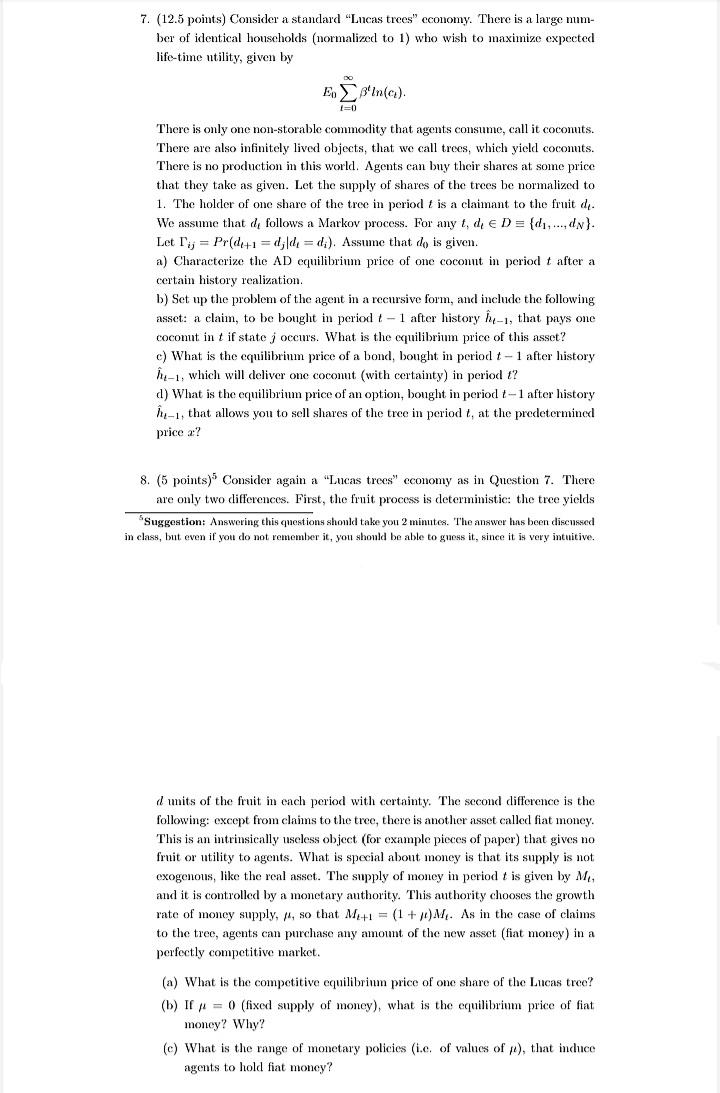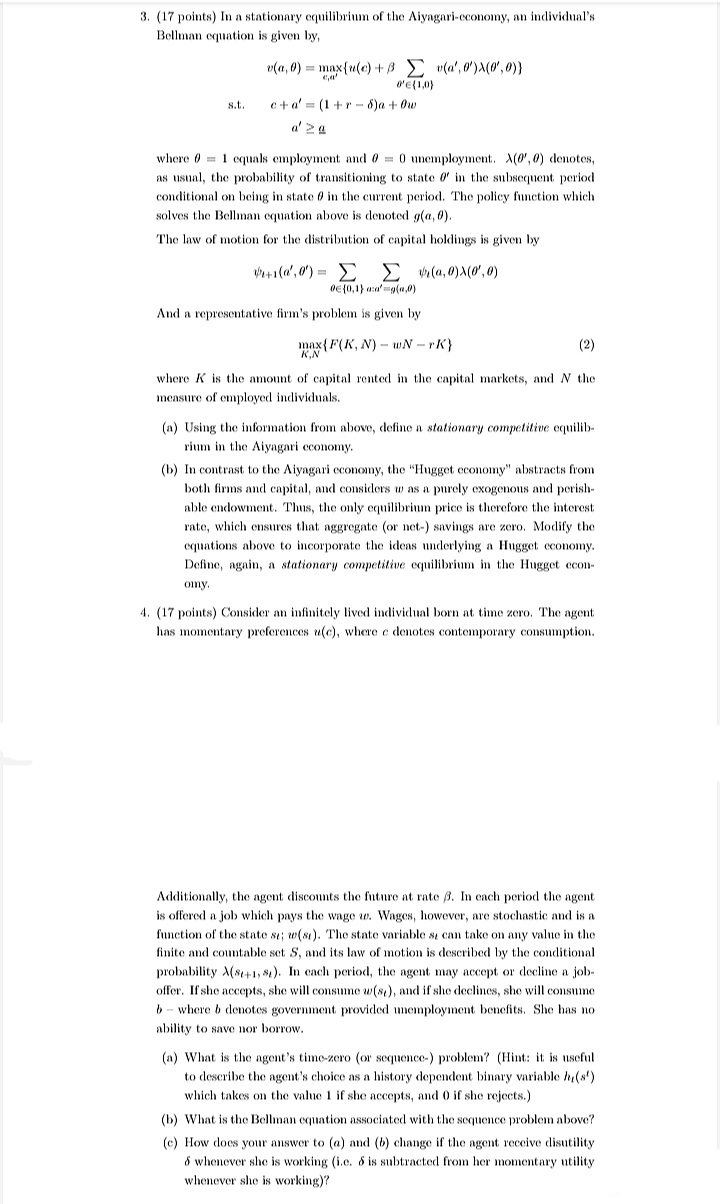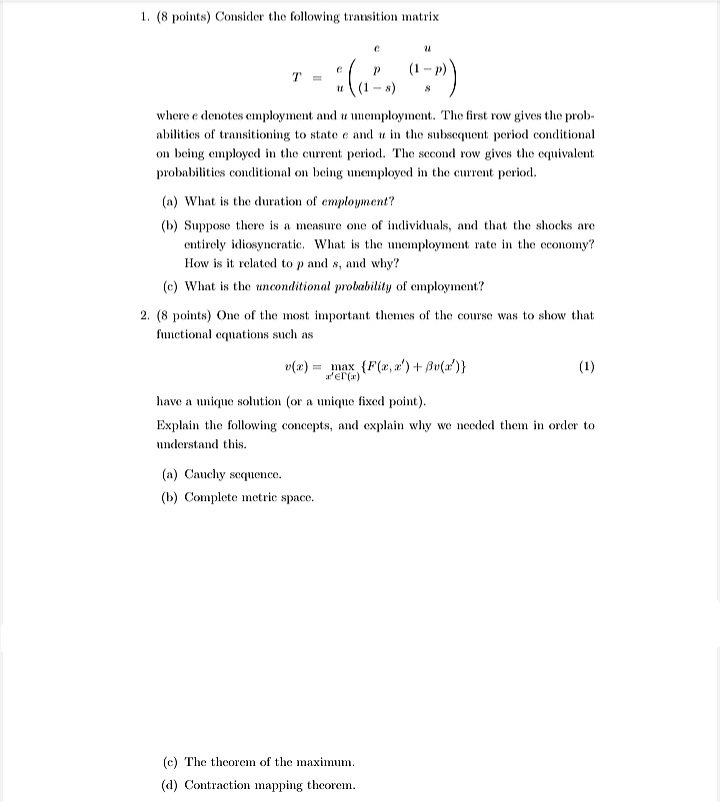


Implement the formula for easy understanding thankyou
7. (12.5 points) Consider a standard "Lucas trees" economy. There is a large num- ber of identical households (normalized to 1) who wish to maximize expected life-time utility, given by En > Btin(c). 1=0 There is only one non-storable commodity that agents consume, call it coconuts. There are also infinitely lived objects, that we call trees, which yield coconuts. There is no production in this world. Agents can buy their shares at some price that they take as given. Let the supply of shares of the trees be normalized to 1. The holder of one share of the tree in period & is a claimant to the fruit de- We assume that d, follows a Markov process. For any &, de E D = (d1,..., dy). Let Ty = Pr(dit1 = did, = d;). Assume that do is given. a) Characterize the AD equilibrium price of one coconut in period t after a certain history realization. b) Set up the problem of the agent in a recursive form, and include the following asset: a claim, to be bought in period t - 1 after history he-1, that pays one coconut in t if state j occurs. What is the equilibrium price of this asset? c) What is the equilibrium price of a bond, bought in period t - 1 after history he-1, which will deliver one coconut (with certainty) in period ? d) What is the equilibrium price of an option, bought in period t-1 after history he-1, that allows you to sell shares of the tree in period t, at the predetermined price a? 8. (5 points)" Consider again a "Lucas trees" economy as in Question 7. There are only two differences. First, the fruit process is deterministic: the tree yields "Suggestion: Answering this questions should take you 2 minutes. The answer has been discussed in class, but even if you do not remember it, you should be able to guess it, since it is very intuitive. d units of the fruit in each period with certainty. The second difference is the following: except from claims to the tree, there is another asset called fiat money. This is an intrinsically useless object (for example pieces of paper) that gives no fruit or utility to agents. What is special about money is that its supply is not exogenous, like the real asset. The supply of money in period t is given by Me, and it is controlled by a monetary authority. This authority chooses the growth rate of money supply, /, so that Meth = (1 + p) Me. As in the case of claims to the tree, agents can purchase any amount of the new asset (fiat money) in a perfectly competitive market. (a) What is the competitive equilibrium price of one share of the Lucas tree? (b) If a = 0 (fixed supply of money), what is the equilibrium price of fiat money? Why? (c) What is the range of monetary policies (i.c. of values of p), that induce agents to hold fiat money?3. (17 points) In a stationary equilibrium of the Aiyagari-economy, an individual's Bellman equation is given by, v(a, 0) = maxfu(c) +# > o(a', ')>(0',0)) D'E(1,0} s.t. cta'= (1+r - 6)a+0w a' 2 4 where # = 1 equals employment and & = 0 unemployment. A(0', 0) denotes, as usual, the probability of transitioning to state & in the subsequent period conditional on being in state O in the current period. The policy function which solves the Bellman equation above is denoted g(a, 0). The law of motion for the distribution of capital holdings is given by And a representative firm's problem is given by max ( F(K, N) - WN - rK} (2) where K is the amount of capital rented in the capital markets, and N the measure of employed individuals. (a) Using the information from above, define a stationary competitive equilib rium in the Aiyagari economy. (b) In contrast to the Alyagari economy, the "Hugget economy" abstracts from both firms and capital, and considers w as a purely exogenous and perish- able endowment. Thus, the only equilibrium price is therefore the interest rate, which ensures that aggregate (or net-) savings are zero. Modify the equations above to incorporate the ideas underlying a Hugget economy. Define, again, a stationary competitive equilibrium in the Hugget ccon- omy. 4. (17 points) Consider an infinitely lived individual born at time zero. The agent has momentary preferences u(c), where c denotes contemporary consumption. Additionally, the agent discounts the future at rate . In each period the agent is offered a job which pays the wage w. Wages, however, are stochastic and is a function of the state at; w(st). The state variable s can take on any value in the finite and countable set S, and its law of motion is described by the conditional probability A(st+1, $1). In each period, the agent may accept or decline a job- offer. If she accepts, she will consume w(s ), and if she declines, she will consume b - where b denotes government provided unemployment benefits. She has no ability to save nor borrow. (a) What is the agent's time-zero (or sequence-) problem? (Hint: it is useful to describe the agent's choice as a history dependent binary variable hi(s') which takes on the value 1 if she accepts, and 0 if she rejects.) (b) What is the Bellman equation associated with the sequence problem above? (c) How does your answer to (a) and (6) change if the agent receive disutility 6 whenever she is working (i.c. 5 is subtracted from her momentary utility whenever she is working)?1. (8 points) Consider the following transition matrix T = where e denotes employment and a unemployment. The first row gives the prob- abilities of transitioning to state e and a in the subsequent period conditional on being employed in the current period. The second row gives the equivalent probabilities conditional on being unemployed in the current period. (a) What is the duration of employment? (b) Suppose there is a measure one of individuals, and that the shocks are entirely idiosyncratic, What is the unemployment rate in the economy? How is it related to p and s, and why? (c) What is the unconditional probability of employment? 2. (8 points) One of the most important themes of the course was to show that functional equations such as "() = max {F(a, ') + Bu(a')} (1) have a unique solution (or a unique fixed point). Explain the following concepts, and explain why we needed them in order to understand this. (a) Cauchy sequence. (b) Complete metric space. (c) The theorem of the maximum. (d) Contraction mapping theorem












